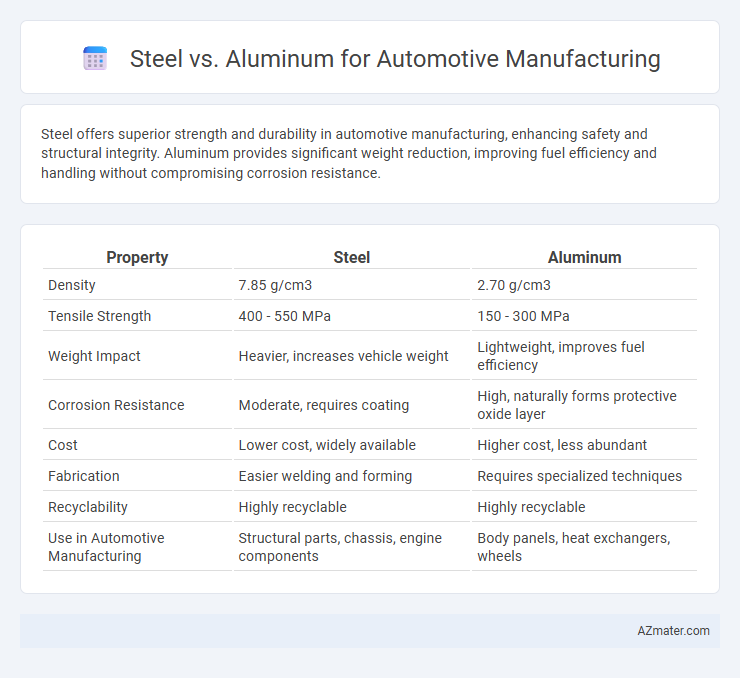Steel offers superior strength and durability in automotive manufacturing, enhancing safety and structural integrity. Aluminum provides significant weight reduction, improving fuel efficiency and handling without compromising corrosion resistance.
Table of Comparison
| Property | Steel | Aluminum |
|---|---|---|
| Density | 7.85 g/cm3 | 2.70 g/cm3 |
| Tensile Strength | 400 - 550 MPa | 150 - 300 MPa |
| Weight Impact | Heavier, increases vehicle weight | Lightweight, improves fuel efficiency |
| Corrosion Resistance | Moderate, requires coating | High, naturally forms protective oxide layer |
| Cost | Lower cost, widely available | Higher cost, less abundant |
| Fabrication | Easier welding and forming | Requires specialized techniques |
| Recyclability | Highly recyclable | Highly recyclable |
| Use in Automotive Manufacturing | Structural parts, chassis, engine components | Body panels, heat exchangers, wheels |
Introduction to Steel and Aluminum in Automotive Manufacturing
Steel and aluminum are essential materials in automotive manufacturing due to their distinct properties and performance benefits. Steel offers superior strength, durability, and cost-effectiveness, making it ideal for structural components and safety-critical parts. Aluminum provides lightweight characteristics that enhance fuel efficiency and reduce emissions, driving its increased use in body panels and engine components.
Key Properties: Steel vs Aluminum
Steel offers superior tensile strength and durability, making it ideal for vehicle safety components, whereas aluminum excels in lightweight properties that enhance fuel efficiency. Steel's higher density contributes to better impact resistance, while aluminum's corrosion resistance and malleability support design flexibility. The choice between steel and aluminum in automotive manufacturing depends on balancing structural integrity with weight reduction goals.
Weight and Fuel Efficiency Considerations
Steel offers high strength and durability but is significantly heavier than aluminum, impacting overall vehicle weight and fuel efficiency. Aluminum's lightweight properties reduce vehicle mass, contributing to improved fuel economy and lower emissions in automotive manufacturing. Selecting aluminum alloys enables manufacturers to design lighter, more fuel-efficient vehicles without sacrificing structural integrity.
Strength, Durability, and Crash Performance
Steel offers superior tensile strength and enhanced crash absorption, making it a preferred choice for critical structural components in automotive manufacturing. Aluminum provides excellent corrosion resistance and lightweight properties that improve fuel efficiency without significantly compromising durability. The combination of steel's impact resistance and aluminum's weight reduction enhances overall vehicle safety and performance during collision events.
Corrosion Resistance and Longevity
Steel offers superior strength and durability but is more prone to corrosion without proper treatment, requiring coatings or galvanization to enhance longevity in automotive manufacturing. Aluminum provides excellent corrosion resistance due to its natural oxide layer, leading to reduced maintenance and longer lifespan in vehicles exposed to harsh environments. Choosing between steel and aluminum balances corrosion resistance and longevity against weight and cost considerations in automotive applications.
Manufacturing Processes and Formability
Steel offers superior formability and higher tensile strength, enabling easier stamping and shaping in automotive manufacturing. Aluminum, while lighter and corrosion-resistant, requires more advanced forming techniques like hydroforming and may face challenges with springback during shaping. Manufacturing processes for steel often involve conventional presses and dies, whereas aluminum demands precise thermal and mechanical controls to maintain dimensional accuracy and structural integrity.
Cost Comparison: Steel vs Aluminum
Steel offers a lower material cost compared to aluminum, making it a more budget-friendly choice for large-scale automotive manufacturing. Although aluminum is more expensive upfront, its lightweight properties contribute to improved fuel efficiency and lower emissions, potentially offsetting initial costs over the vehicle's lifespan. Manufacturing processes such as welding and forming vary in expense between steel and aluminum, with steel generally requiring less specialized equipment, further influencing overall production costs.
Environmental Impact and Sustainability
Steel offers higher recyclability rates, with approximately 88% of automotive steel being recycled globally, significantly reducing energy consumption and carbon emissions compared to primary production. Aluminum provides lightweight benefits that improve fuel efficiency, cutting greenhouse gas emissions during vehicle operation, but its extraction and refining require more energy and cause greater environmental disturbance. Both materials impact sustainability, yet steel's established recycling infrastructure and lower embodied energy make it a more eco-friendly choice for automotive manufacturing.
Industry Trends and Case Studies
Steel remains dominant in automotive manufacturing due to its superior strength, cost-effectiveness, and recyclability, accounting for approximately 60% of vehicle materials globally in 2023. The rise of lightweight electric vehicles (EVs) has accelerated aluminum adoption, with a 15% increase in aluminum content per EV to enhance range and efficiency, as demonstrated by Tesla's Model S and Ford F-150 Lightning. Case studies reveal steel-aluminum hybrid structures optimize crash safety and weight reduction, exemplified by BMW's use of aluminum in body panels combined with high-strength steel frames to improve overall vehicle performance.
Choosing the Right Material: Factors and Future Outlook
Steel offers superior strength and cost-effectiveness, making it ideal for structural components and safety-critical applications in automotive manufacturing, while aluminum's lightweight properties contribute significantly to fuel efficiency and emissions reductions. Material selection depends on factors such as vehicle performance goals, manufacturing costs, recyclability, and regulatory compliance, with many manufacturers adopting multi-material strategies to optimize benefits. Future trends indicate increased use of advanced high-strength steels and aluminum alloys, driven by stricter emissions standards and the push toward electric and autonomous vehicles.

Infographic: Steel vs Aluminum for Automotive Manufacturing
 azmater.com
azmater.com